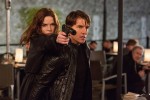Out of every A-list movie star, Tom Cruise is probably among the most divisive.
At face value, he’s a man past his prime: every movie he’s made since the early 2000s – from the less-than-pleasurable “Vanilla Sky” to the less-than-less-than-pleasurable “Rock of Ages” – seems to have slowed his career to a crawl, both critically and financially.
Then comes the first 30 seconds of “Mission: Impossible – Rogue Nation,” which includes the plane stunt. Yes, that plane stunt – the one that has been on every commercial, billboard, poster and trailer for this movie since it first entered the public eye. The scene happens before the opening credits even pass through the audience’s thoughts.
The stunt is a reminder that, on one hand, Cruise is now an action star in his 50s who requires some crazy endeavors to get real audience attention. But also, he’s Tom Cruise – a man so insane and over-the-top that he opens the fifth installment of his quintessential, formulaic franchise by dangling out of a flying airplane for the world’s entertainment.
What he’s doing on the plane, however, is never touched upon. Most of the details behind this “Mission: Impossible” storyline, as in all previous ones, are pretty unnecessary. “Rogue Nation” really drives this point home due to its overwhelming similarities with the past entries in the series. When the U.S. government takes a closer look at Ethan Hunt’s (Tom Cruise) reckless affairs (like the first film), Hunt and his fellow Impossible Mission Force agents are put on the chopping block by CIA director Alan Hunley (Alec Baldwin).
So Hunt goes out without the government’s backing (like the fourth film) trying to catch a secret terror organization called the Syndicate. He slowly brings together his crackpot team (like the third film), including past “Mission: Impossible” participants Benji Dunn (Simon Pegg), William Brandt (Jeremy Renner) and Luther Stickell (Ving Rhames), to do ludicrous stunts and break into secured vaults.
At that point, the film’s storyline of tracking down bad guys gets a bit muddled. The biggest addition to the cast this time around is Rebecca Ferguson as Ilsa Faust, a woman who goes from being an agent to a double agent, and maybe a triple agent or quadruple agent by the film’s end. It’s fairly unclear.
What is clear is that Faust is the closest thing to a female Hunt that “Mission: Impossible” has created so far, and watching the two do battle with their respective foes is an enthralling spectacle.
“Rogue Nation” is all about having fun, and every member of the cast is doing it without holding back. Baldwin teeters between comedic and dramatic faces at the flick of a switch, Pegg plays the bumbling technician in a manner that makes him seem truly terrified and Sean Harris, as the elusive Solomon Lane, does a great Bond villain impersonation as he dodges Hunt’s every move.
Whether it’s entirely coherent or not, most of the film’s plot consists of Hunt and Lane trying over and over again to plan ahead of each other. Almost every single thing that happens in “Rogue Nation” can be attributed to some character saying, “Aha! I expected you to do that.”
But at the same time, that complexity allows director Christopher McQuarrie to mindlessly go to outrageous extents for more well-crafted action sequences than the “Mission: Impossible” series is even known for. Whether it be Hunt’s terrible handling of motor vehicles along cliffsides or an opera scene that will go down as the series’ most well-choreographed moment ever, “Rogue Nation” is harrowing, exciting and a terrific theatrical experience.
Cruise is no longer in the must-see movie period of his career. But he will always be in the “Mission: Impossible” phase, as the type of guy that never really gets old but just keeps on moving towards the same great personal heights (with a wire or two attached). Cruise is a timeless movie star, and fortunately for him, “Rogue Nation” is great enough to let his fans and critics come to terms with that.
– Sebastian Torrelio
